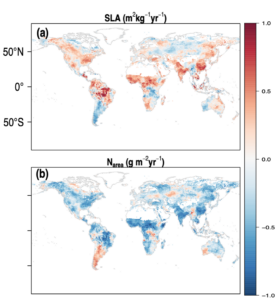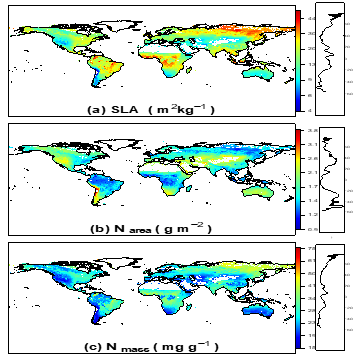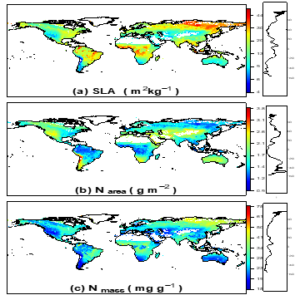Dr Ning Dong from the REALM and LEMONTREE teams led a recent paper published in Global Ecology and Biogeography introducing a novel method to produce leaf-trait maps (Figure 1) based on eco-evolutionary optimality theory.
Global leaf-trait mapping based on optimality theory
Figure 1 Global patterns and latitudinal distribution of modelled specific leaf area (SLA, m2 kg–1), leaf nitrogen per unit area (Narea, g m–2) and leaf nitrogen per unit mass (Nmass, mg g–1).
Plant traits are important for the functioning of ecosystems and how they affect and are affected by climate. Worldwide patterns of community mean leaf nitrogen per unit area (Narea) can be predicted based on a hybrid approach by a structural component (proportional to LMA) and a metabolic component of leaf N (proportional to Vcmax25), and both components can be predicted from the physical environment based on optimality theories. These maps were evaluated against plot-level trait data from the TRY database with over 2000 sites. The results showed that the predictions had a high degree of accuracy, with R2 values of 73% for SLA, 38% for Nmass and 28% for Narea.
The optimal trait values of a community may shift in response to temporal and spatial changes, resulting in variability in the relationships between the environment, traits and ecosystem. Therefore, it is important to quantify the driving factors and understand the underlying mechanisms that determine this variability. This is one of the outstanding scientific questions that need to be addressed (Chacón-Labella et al. 2023). In this study, we generated trends of spatiotemporal trends in plant traits for the past two decades, the patterns are not only consistent in leaf level optimisation, but also showed surprising agreement with satellite-derived SLA. We also demonstrated that global warming should have caused a decline in the N content of leaves and an increase in SLA.

Figure 2 Global temporal trends (Mann-Kendall coefficients) in modelled specific leaf area (SLA, a), leaf nitrogen per unit area (Narea, b) during 1992–2015.
Last, with the increases in the availability of leaf-trait data and computational power, large-scale analyses of trait-environment relationships have been conducted to develop global trait maps. However, these maps show substantial differences that have yet to be resolved. In the paper, we discussed the possible reasons, such as: 1) there is a bias towards temperate ecosystems in the northern hemisphere, which limits the applicability of these models in other regions. 2) the choice of environmental covariates used as predictors is subjective and differs among products. 3) some trait-environment relationships depend on plant strategies, which may not be accounted for in some global trait maps. 4) different upscaling methods have been used without a clear assessment of their relative merits.
Overall, the optimality-based leaf trait maps have great potential for macroecological applications as they allow for more flexibility and realism compared to PFT-based models. These trait maps can be used as input data for land-surface models to monitor and model primary production, also can integrate the acclimate or adaptation of plant traits to the climate in the models to improve our understanding of how plant communities respond to environmental change.
You can read the full paper here:
Dong, N., Dechant, B., Wang, H., Wright, I.J. & Prentice, I.C. 2023. Global leaf-trait mapping based on optimality theory. Global Ecology and Biogeography, https://doi.org/10.1111/geb.13680
Reference
Chacón-Labella, J., Hinojo-Hinojo, C., Bohner, T., Castorena, M., Violle, C., Vandvik, V., & Enquist, B. J. (2023). How to improve scaling from traits to ecosystem processes. Trends in Ecology & Evolution, 38(3), 228-237.


